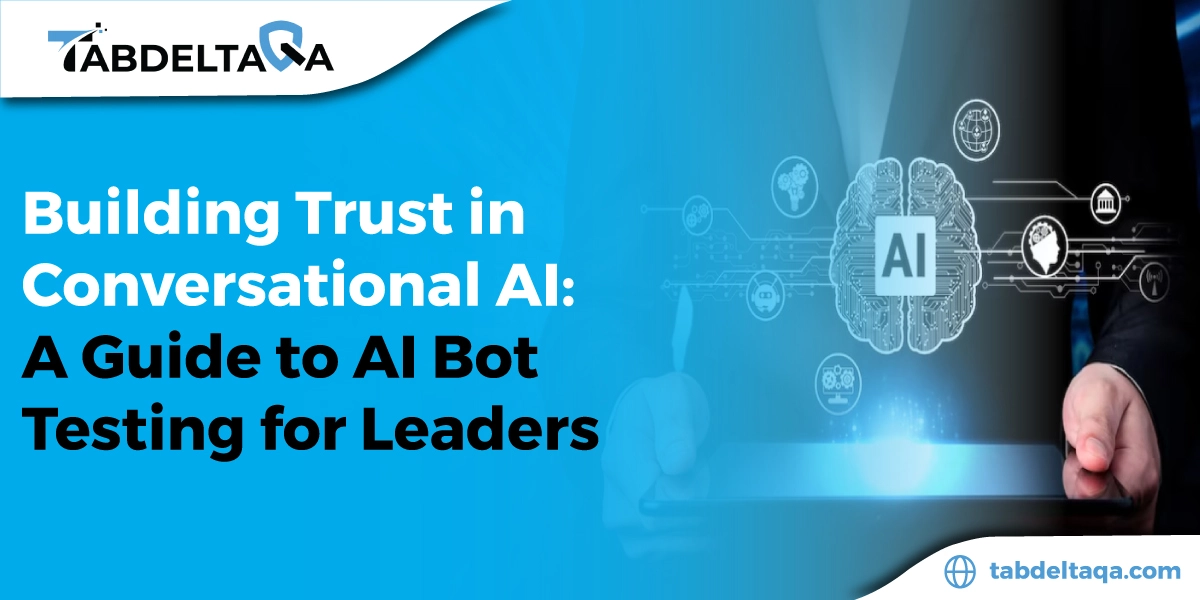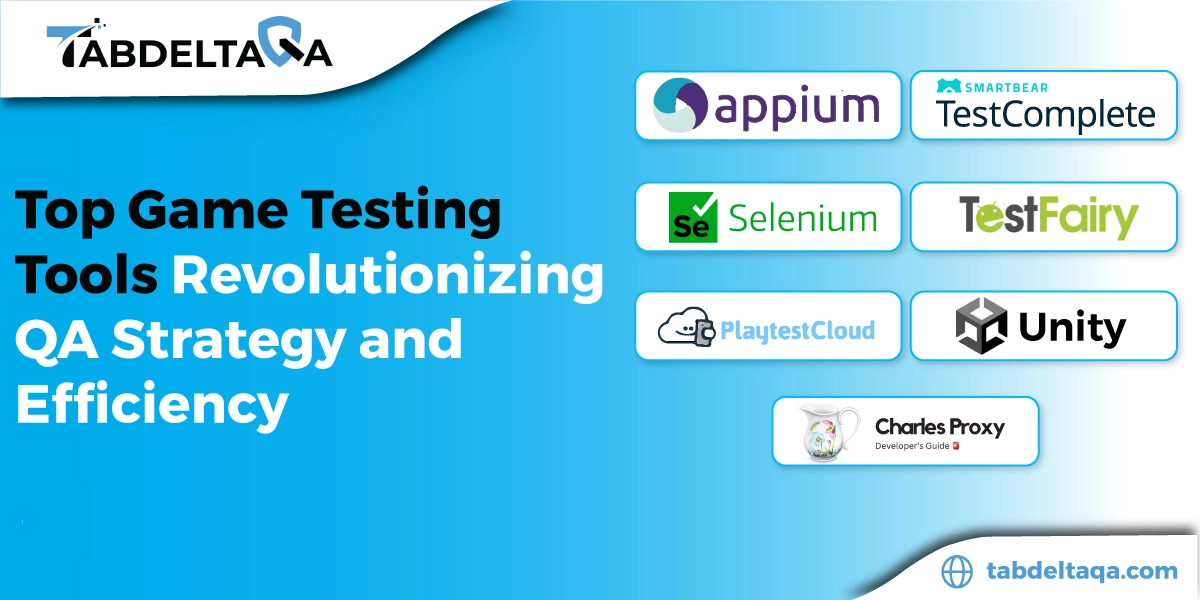Building Trust in Conversational AI: A Guide to AI Bot Testing for Leaders
- July 25, 2025

AI has the ability to evaluate vast volumes of data, identify patterns that people overlook, and produce insights more quickly than ever before. It is therefore extremely valuable for business. As software QA automation services businesses deal with global challenges like labor shortages, supply chain problems, and sustainability requirements, the value of AI becomes even more significant. In 2025, the worldwide chatbot industry is expected to be worth $15.57 billion.
Why Trust Matters in Conversational AI?
The success of conversational AI depends on trust, as it has a direct effect on user happiness, adoption, and the total value that can be obtained from the technology. Users may not be inclined to use or depend on these systems if they don’t trust them, which could result in neglect and even bad outcomes for the companies or organizations that use them.
▶The Human-AI Interaction Challenge
➢Misunderstandings lead to user frustration
Human-AI miscommunications pose a serious problem in human-AI interaction and frequently result in user annoyance. These misconceptions may result from the ways that AI and humans view, analyze, and react to data and circumstances differently.
➢AI as a brand ambassador
With its ability to communicate via text, audio, and even visual material, this AI agent test automation consultant provides a dynamic means of user engagement.
▶Risks of Unreliable AI Bots
➢Customer churn
AI Churn Prediction is a game-changing solution that boosts revenue growth and competitive advantage in addition to improving customer retention. One of the biggest problems telecom businesses still face is customer attrition, which affects both revenue and loyalty to clients.
➢Data privacy issues
Among the dangers are algorithmic prejudice, the abuse of personal information, and the possibility of technological manipulation or hacking. Furthermore, people may find it challenging to comprehend and regulate how their data is used by AI systems, as they are not always transparent in their decision-making process.
➢Reputational damage
The danger of cyberattacks and data breaches increases dramatically if training data used by AI systems is not adequately safeguarded. A company’s reputation can be damaged by compromised data, and regulatory penalties may result. Ignoring moral issues and disseminating biased AI judgments might have negative legal and reputational effects.
Also Read :- Top 7 Automation Testing Company in India for 2025-26
What Is AI Bot Testing?
AI bot testing, sometimes referred to as chatbot testing or conversational AI testing, is the process of assessing how well AI-powered chatbots work, perform, and interact with users. The software test consultant guarantees that the chatbot can comprehend user inputs precisely, offer insightful answers, and preserve context in a variety of situations. This involves testing a number of factors, including comprehension capacity, response precision, and general user experience.
▶Manual vs. Automated Testing
While manual testing depends on human testers to conduct tests, AI bot testing, as used in software testing, refers to the use of AI & ML to automate and improve the testing process. While automated testing uses tools and scripts to run tests, AI-powered automation goes one step further by allowing bots to learn and adjust to unique scenarios, which could increase protection, speed, and reliability.
Whereas manual test automation services depend on human testers, automated testing employs tools and scripts to carry out tests. While manual testing is more adaptable and performs better in exploratory and usability testing, automated testing is quicker, more dependable, and better suited for repetitive tasks.
Key Areas to Test in Conversational AI Bots
▶Natural Language Understanding (NLU)
The two primary functions of the NLU are to determine the meaning of a person’s speech and to produce a reaction based on that meaning. Numerous applications, such as chatbots, virtual assistants, sales, and customer support, can make use of NLU software. While some NLU software solutions are made to merely recognize the input’s purpose, others are made to produce a response as well. NLU is used by many businesses; for example, Netflix uses it to suggest films or TV series, Google utilizes it in its search engine, and Amazon uses it to assist you in completing purchases. NLU assists these businesses in giving their clients a better user experience.
▶Dialogue Management
The goal of dialogue management testing in conversational AI is to ensure that the bot comprehends human input, keeps the conversation flowing naturally, and responds with precise, pertinent information. Natural language comprehension, conversation flow, handling mistakes, and the bot’s capacity to adjust to user behavior and context are important areas to test.
▶User Experience (UX)
Understanding user intent, conversational flow, answer accuracy, and fallback mechanisms is important in examining conversational AI bot User Experience (UX). Additionally, QA automation testing services should guarantee that the chatbot is easy to use, has an acceptable tone, simple navigation, and responds quickly.
Security and Compliance
Data privacy, authentication, managing malicious input, and adherence are important areas to evaluate in conversational AI bots. Testing should guarantee safe data transfer and storage, and appropriate authentication procedures.
Testing Methods and Tools
▶Unit Testing for AI Modules
Strong testing procedures are necessary to establish confidence in conversational AI, and unit testing is essential for confirming the accuracy of particular AI modules. Prior to integration with other system components, unit tests are primarily concerned with confirming that individual components operate as intended when isolated. By detecting and correcting mistakes early on, this method helps to avoid cascade failures and create a conversational AI system that is more dependable and trustworthy.
▶Regression Testing
Conversational AI regression software, QA automation services, and testing ensure that upgrades or modifications don’t interfere with already-existing features. It covers topics like intent recognition, behavioral paths, and expected responses, and focuses on confirming that the bot still operates as intended following changes. Regression testing makes sure that the bot’s essential features aren’t adversely affected by new updates. This investment is safeguarded by regression testing, which assures the system frequently operates & functions over time.
▶A/B Testing with Real Users
An essential technique for conversational AI optimization is A/B testing with actual users, which enables data-driven choices about chatbot performance and design. Businesses can determine which aspects of a chatbot resonate best by presenting various iterations to user segments and tracking their interactions. AI-powered solutions can streamline the testing process by automating processes like traffic allocation, experiment setup, and tracking performance.
▶Popular Tools to Use
➢Rasa Test
For creating conversational AI applications, such as chatbots and virtual assistants, Rasa is a flexible and open-source platform. It gives developers the foundations and resources they need to handle conversations, comprehend natural language, and produce interactive conversational experiences.
➢Botium
A well-liked open-source framework for conversational AI and chatbot testing is called Botium. It supports more than 55 conversational AI technologies and takes a no-code approach, making it usable by both technical and non-technical users. Functional testing, performance reviews, and security checks, including GDPR compliance, are areas in which Botium shines. Additionally, it offers integrated NLP analytics and replicates authentic user behaviors.
➢TestMyBot
A framework for automating tests for your chatbot project is called TestMyBot. It is totally unbiased and unconcerned with any development tools that may be used. This free open-source tool captures your test cases, which may then be automatically executed repeatedly against your chatbot implementation.
➢Dialogflow CX test console
Google’s Dialogflow CX technology allows users to create conversational AI agents by providing a state-based, visual method for creating intricate dialogues. It enables programmers to design complex virtual agents for a range of platforms, including interactive voice response systems, chat, and speech.
Also Read :- Types of Functional Testing and Their Role in Software Quality Assurance
Best Practices for Leaders to Build Trust
▶Establish Clear Testing KPIs
If workers are unaware of their performance goals, they can’t put in the effort to reach them. Therefore, establishing your key performance indicators clearly is the first step in encouraging KPI ownership and accountability to assist staff in reaching their KPIs.
Clearly defining expectations helps to define success and how it will be evaluated. KPIs are quantifiable numbers that indicate how successfully your goals are being met. Therefore, comprehending your company’s aims and goals is the initial step to designing KPIs.
▶Integrate Testing Early (Shift-Left)
Leaders should concentrate on developing a collaborative culture, putting strong automation in place, and making sure that feedback loops are quick in order to promote trust and develop a strong team through early integration testing (shift-left). This entails including testing from the start of the development process, promoting cross-functional cooperation, and using automation to speed up issue resolution and feedback.
▶Involve Cross-functional Teams
Leaders should place a high priority on open communication, set common objectives, support cooperation, and encourage openness in order to build trust across cross-functional teams. Building trust and a healthy team dynamic also requires actively including team members in decision-making, acknowledging their efforts, and giving them constructive criticism.
▶Continuous Monitoring Post-Launch
Leaders should place a high priority on ongoing observation, open communication, and prompt, efficient resolution of concerns and comments in order to build confidence after launch. This AI bot testing involves setting up transparent channels for customer feedback, paying attention to what people have to say, and making adjustments to the product or service.
Ready to Build Trust in Your AI Bot? Start with Smart Testing Today
For executives, AI bot testing involves ensuring that a chatbot performs as planned, produces a satisfying user experience, and gives precise and relevant data. This involves establishing specific goals, creating a variety of test scenarios, and ranking important features. In addition, leaders should prioritize security, fairness, and performance and use automation to ensure scalable and effective testing. Hire a software test consultant to start auditing your AI bot today.
Outline Your QA Requirements - Connect with Experts!
Connect NowLet's Discuss Your Quality Assurance Needs!
Recent Blog
Let's Start a Conversation!
We value your input! Reach out to us with your inquiries or suggestions, and let's start a conversation.






